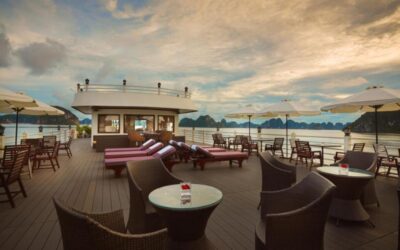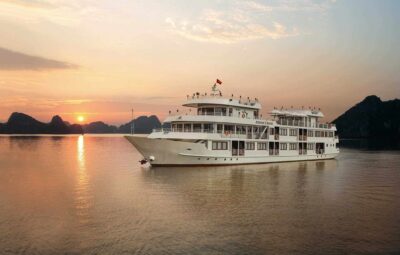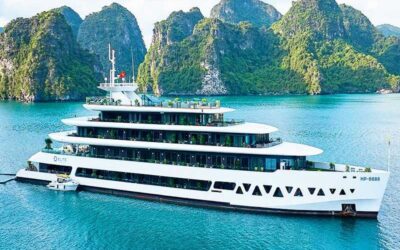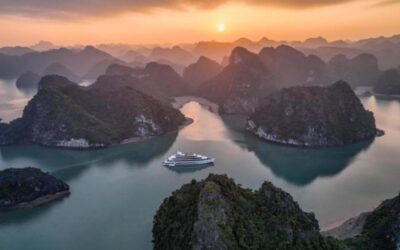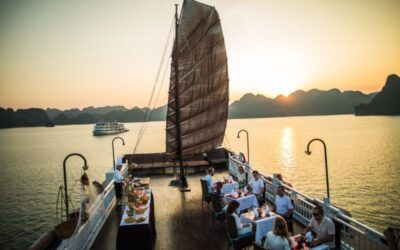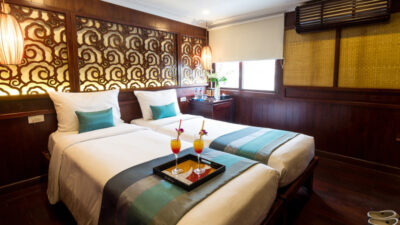When you dream of swaying palms, pristine white sand beaches, and shimmering turquoise waters in Southeast Asia, Thailand might dominate the conversation. But let’s change that perspective. Vietnam, a land celebrated for its rich culture and dramatic landscapes, also boasts an extraordinary Vietnamese coastline stretching over 3400km (2113 miles). This immense shoreline hides a treasure trove of stunning beaches in Vietnam, from vibrant urban stretches buzzing with energy next to cities like Nha Trang and Da Nang, to the tranquil shores of coral-ringed tropical islands like Phu Quoc and Con Dao. This guide is your passport to exploring the finest beach destinations Vietnam has to offer, uncovering the unique character, activities, and essential planning tips for an unforgettable coastal journey, perfect for Indian travellers seeking sun, sand, and adventure.

Why Choose Vietnam’s Beaches for Your Next Holiday?
Vietnam’s coastline offers a remarkable diversity that caters to every type of beach lover. Whether you seek the convenience of a city beach like the famous strip in Nha Trang, the world-class kitesurfing conditions of Mui Ne, the family-friendly shallows of My Khe Beach (Quang Ngai), or the sheer natural beauty and seclusion of the Con Dao archipelago, you’ll find your perfect spot. The country’s length ensures varied coastal geography, from the dramatic limestone karsts framing northern coves to the endless stretches of golden sand in the central region and the idyllic white sand beaches of southern islands like Phu Quoc. While Vietnam is a rising star in beach tourism, many areas still retain an untouched charm, offering a chance to experience pristine beauty before the crowds arrive. Balancing this growing popularity with sustainable practices is key to preserving these incredible natural assets.
READ MORE: Exploring the majestic Vietnamese mountains
Best Beaches in Vietnam: A Regional Exploration
Let’s journey down the coast and explore the highlights of Vietnam’s beaches, region by region.
Northern Vietnam: Dramatic Scenery and Sheltered Coves
While perhaps less famous for beaches than other regions, Northern Vietnam offers unique coastal experiences amidst stunning karst landscapes, particularly around Ha Long Bay and its neighbours.
Cat Ba Island (Hai Phong): Gateway to Lan Ha Bay
As the largest island in the Cat Ba Archipelago, nestled beside the less-crowded Lan Ha Bay (a UNESCO Biosphere Reserve), Cat Ba offers rugged beauty. Its most popular beaches are the trio of coves – Cat Co 1, 2, and 3 – featuring soft sand tucked between limestone cliffs, offering sheltered swimming. Tung Thu Beach provides a longer stretch. The *location type* is island-based, with moderate *development levels*. Enjoy swimming, kayaking through the bay’s karst formations, rock climbing, or visiting Cat Ba National Park. *Accessibility* is via ferry/speedboat from Hai Phong or Tuan Chau (near Ha Long). Visit during quieter months (avoid peak summer weekends) for the best experience, as mentioned for *off-season visits*.

Quan Lan Island (Quang Ninh Province): Untouched Beauty
Located in Bai Tu Long Bay, Quan Lan offers a more tranquil, *off-the-beaten-path* experience. Beaches like Quan Lan, Son Hao, and Minh Chau boast long stretches of pristine *white sand* and remarkably *clear waters*, with minimal *development*. It’s perfect for swimming, relaxing, exploring by motorbike, and enjoying fresh seafood. *Accessibility* is via ferry from Cai Rong port.
Ha Long Bay Beaches (Quang Ninh Province)
While famed for its limestone pillars, Ha Long Bay itself has beaches. Bai Chay is a large, *artificial beach* near the main tourist hub. For a more natural experience, many *Ha Long Bay cruises* stop at Ti Top Island, offering panoramic views and a small swimming beach. The more secluded Ban Chan beach offers *white sand* for those on longer or private tours.
Central Vietnam: Golden Sands, Cultural Charm & Watersports
This region is arguably Vietnam’s beach heartland, home to famous stretches of sand near vibrant cities and historical sites like Hoi An and Hue.
My Khe Beach (Da Nang): World-Renowned Urban Beach
Often listed among the world’s best, My Khe Beach in Da Nang is a stunningly long and wide expanse of soft *white sand* meeting the clear, blue South China Sea. Its *location type* is urban, with significant *development* including resorts and restaurants, making it excellent for *people-watching*. It’s a hub for activities: safe swimming zones, surfing (seasonal), jet-skiing, and parasailing. *Accessibility* is excellent from Da Nang city centre. Be aware of potential strong undertows, especially in winter. Nearby attractions include the Marble Mountains and Son Tra Peninsula.
An Bang Beach (Hoi An): Relaxed Vibes near Ancient Town
Just 3km (2 miles) north of charming Hoi An, An Bang Beach offers a more bohemian, laid-back atmosphere compared to My Khe. It boasts a wonderful stretch of fine *golden sand* (suffering less erosion than nearby Cua Dai) and expansive sea views towards the distant Cham Islands. With moderate *development* featuring cool cafes and boutique stays, it’s perfect for swimming, sunbathing, and enjoying seafood. Its *accessibility* from Hoi An (taxi, bicycle) makes it ideal to use as a base for exploring the area. You can easily arrange *island hopping* tours to the Cham Islands from here.

Cham Islands (off Hoi An): UNESCO Biosphere Reserve
A cluster of eight islands easily reachable on a day trip or overnight stay from Hoi An/An Bang. Designated a *UNESCO Biosphere Reserve*, the Cham Islands boast incredible marine biodiversity (over 200 fish species) and excellent *snorkeling* and *diving* opportunities around coral reefs. Hon Lao is the main island with beaches like Bai Chong and Bai Ong. Expect coconut-white beaches and a sleepy, traditional fishing village feel.
Non Nuoc Beach (Da Nang)
South of My Khe, Non Nuoc offers another vast stretch of *white sand* and clear waters, generally quieter than My Khe. Its *location* near the Marble Mountains makes it convenient for combining beach time with sightseeing. *Development* includes several high-end resorts.
Lang Co Beach (Hue): Lagoon Meets Sea
Picturesquely situated on a sandy peninsula between a calm lagoon and the open sea, near the stunning Hai Van Pass. Lang Co Beach offers fine *golden sand* and relatively *clear waters* in a serene setting. *Development* is moderate. It’s great for swimming, relaxation, and fresh seafood. *Accessibility* is easy by road from Da Nang or Hue.

My Khe Beach (Quang Ngai Province): Family-Friendly Gem
Not to be confused with Da Nang’s beach, this My Khe Beach near Quang Ngai boasts superb fine *white sand* and excellent, safe swimming due to its gentle, *shallow water shelf* – making it perfect for *families*. It stretches for kilometres along a thin spit, offering a quieter, more local experience, especially on weekdays. *Development* is minimal.
South Central Vietnam: Kitesurfing Mecca & Coastal Drives
This stretch is famous for its reliable winds and beautiful coastline, attracting watersports enthusiasts and those seeking scenic drives.
Mui Ne (Phan Thiet): Kitesurfing Capital & Sand Dunes
Once Vietnam’s resort jewel, Mui Ne is now globally renowned as a top spot for *kitesurfing* and windsurfing, thanks to world-class wind conditions, especially from *late October to April*. While tides have eroded parts of the main beach and *overdevelopment* has impacted its charm, sections of *golden sand* remain. The opening of the Dau Giay-Phan Thiet highway cut *travel time from HCMC* to just over two hours. Beyond watersports (with many schools like Mui Ne Kitesurfing School offering lessons), explore the nearby: the stunning Red and White *Sand Dunes*, popular for sledding and sunrise/sunset views, and the mystical Fairy Stream. *Development* is extensive along the main strip.

Nha Trang Beach (Nha Trang City): Vibrant Urban Waterfront
Forming a magnificent 6km (3.75 miles) sweeping arc of *golden sand*, Nha Trang‘s main beach is one Southeast Asia’s great *urban beaches*. Sections are roped off for safe swimming. Popular spots include the Sailing Club and Louisiane Brewhouse. While busy, heading south offers quieter spots. It’s the launching point for value-priced *island hopping* tours for *snorkeling* (though boats can be crowded; consider operators like Rainbow Divers for a better experience). *Development level* is high, with a city backdrop.
Doc Let Beach (Ninh Hoa, near Nha Trang): White Sand & Shallow Waters
Stretching for 18km (11 miles), Doc Let is famed for its *chalk-white sand* and shallow *turquoise waters*, making it visually stunning and great for wading. *Development* has increased significantly, attracting tours from Nha Trang, but heading north towards Bai Bau or Bai Xep reveals more secluded spots. Its *accessibility* is about an hour from Nha Trang.

Quy Nhon (Binh Dinh Province): Authentic Coastal Charm
Offering a more local, less touristy vibe, Quy Nhon features beaches like Quy Nhon Beach and the beautiful Bai Xep (Egg Beach) with its smooth stones. Expect golden sands, clear waters, and a focus on fresh seafood, with lower *development levels*.
Ly Son Island (Quang Ngai Province): Volcanic Beauty & Reefs
A lesser-known gem, Ly Son is a cluster of volcanic islands off the central coast known for its garlic fields and unique geology. It is volcanic origin shapes, creating dramatic landscapes like the To Vo arch. While beaches are smaller and used by fishing boats, the surrounding waters boast clear visibility and accessible coral reefs, offering some of Vietnam’s best *snorkeling*. Take a short ferry to tiny Dao Be (An Binh) for lovely small beaches and an ‘ends of the earth’ feel. *Development* is minimal, mostly homestays. *Accessibility* is via ferry from Sa Ky port.
Southern Vietnam: Idyllic Islands and Coastal Escapes
Home to Vietnam’s most famous islands and beaches easily accessible from Ho Chi Minh City.
Phu Quoc Island (Kien Giang Province): Premier Island Destination
Vietnam’s largest island, Phu Quoc, has rapidly transformed into a major beach destination. It’s famed for its stunning *white sand beaches* and *clear, calm waters*, making it ideal for swimming, sunbathing, *snorkeling*, *diving*, and *island hopping* to the An Thoi archipelago in the south. Key beaches include:
- Sao Beach (Bai Sao): Picture-perfect *white sand* and *mineral-water-clear* sea, often cited as Phu Quoc’s best, though can get busy.
- Khem Beach (Bai Khem / “Cream Beach”): Another stunning *white sand* beach, home to luxury resorts.
- Long Beach (Bai Truong): The longest and most developed beach with numerous resorts, bars, and restaurants.
- Ong Lang Beach: A series of smaller, quieter coves north of the main town, Duong Dong, known for calm seas and sunsets.
- Ganh Dau & Thom Beaches: Quieter, more local feel in the far north.
Explore Phu Quoc National Park, pepper farms, or take the scenic 8km-long Hon Thom Cable Car. *Accessibility* is excellent via Phu Quoc International Airport. While *development* is rapid, pockets of tranquility remain.

Con Dao Islands (Ba Ria-Vung Tau Province): Protected Natural Beauty
An archipelago isolated from the mainland, Con Dao offers striking natural beauty and poignant history. Once a site for political prisons, it’s now protected by Con Dao National Park. The main island, Con Son, is ringed with lovely beaches:
- Dam Trau Beach: Beautiful arc of sand near the airport.
- An Hai Beach: Conveniently located near the main town.
- Dat Doc Beach: Secluded stretch home to the luxurious Six Senses resort.
- Lo Voi Beach: Tranquil spot north of town.
- Bay Canh Island: Famous for sea turtle nesting and release programs.
Expect pristine *white/golden sand*, crystal-*clear waters*, abundant coral reefs for *snorkeling/diving*, and low *development levels*. *Accessibility* is via flights from HCMC or ferries. It offers sheer *natural beauty* and tranquility.
Ho Coc & Ho Tram Beach (Ba Ria-Vung Tau Province): Relaxing HCMC Getaway
Just a 2.5-hour drive from Ho Chi Minh City, Ho Coc offers a tempting stretch of *golden sand* and *clear waters*. It’s part of a longer coastline that includes Ho Tram. While getting busier on weekends, weekdays remain peaceful. The *location type* is coastal mainland, with moderate but growing *development*. It’s a great *HCMC getaway*. Nearby Ho Tram features luxury resorts and golf courses. Both areas have nearby forests and sand dunes.
Vung Tau (Ba Ria – Vung Tau Province)
A long-standing popular weekend escape from HCMC. Vung Tau offers easily accessible beaches like Bai Sau (Back Beach) and Bai Truoc (Front Beach). While perhaps not as stunning as Phu Quoc or Con Dao, its *accessibility* makes it convenient for a quick seaside break. *Development* is significant.
Nam Du Islands (Kien Giang Province): Backpacker Island Idyll
For a truly *off-the-beaten-path*, basic island experience south of Phu Quoc, consider the Nam Du archipelago. The main island, Nam Du, has simple accommodation and beautiful, undeveloped beaches like Bai Cay Men, a lovely half-moon bay with thatched shacks selling seafood. Expect basic *development* and *accessibility* involves a flight/bus to Rach Gia then a speedboat. Best avoided on weekends due to local crowds.
Beach Activities and Water Sports in Vietnam
Beyond simply swimming and sunbathing, Vietnam’s beaches offer a plethora of activities:
- Snorkeling & Diving: Best in Phu Quoc, Con Dao, Nha Trang (islands), Cham Islands, and Ly Son due to coral reefs and clear waters.
- Kitesurfing & Windsurfing: Mui Ne is the undisputed champion due to its excellent wind conditions. Some activity also found in Phan Rang.
- Kayaking & Stand-Up Paddleboarding (SUP): Ideal in calm, scenic waters like Lan Ha Bay (Cat Ba), parts of Phu Quoc, and sheltered bays.
- Surfing: Possible at beaches like My Khe (Da Nang) during the surf season (typically Sep-Mar), though waves are generally moderate.
- Island Hopping: Very popular from Nha Trang, Phu Quoc, and Hoi An (to Cham Islands), often including lunch and snorkeling stops.
- Jet Skiing & Parasailing: Available at more developed beaches like Nha Trang, My Khe (Da Nang), and Long Beach (Phu Quoc).
- Exploring Local Life: Watch fishermen launch traditional round *coracle boats* (especially evenings/mornings in places like Mui Ne, My Khe Da Nang, Ly Son), visit fishing villages, or enjoy fresh seafood at beachside shacks.
READ MORE: Is Vietnam a safe country to visit?
Planning Your Vietnamese Beach Holiday: Best Times & Accommodation
Best Time to Visit Beaches in Vietnam
Vietnam’s long shape means varied climates. Here’s a general guide:
- Northern Vietnam (Cat Ba, Quan Lan, Ha Long): Spring (March-April) and Autumn (September-November) offer pleasant temperatures and less rain. Avoid peak summer (June-August) due to heat, humidity, and potential typhoons.
- Central Vietnam (Da Nang, Hoi An, Hue, Quy Nhon, Ly Son): The dry season from February to August is ideal, with sunny skies and warm temperatures. September to January is the rainy/stormy season.
- South Central Vietnam (Nha Trang, Mui Ne, Phan Rang): Long dry season, generally good year-round but avoid Oct-Dec for heaviest rains in Nha Trang. Mui Ne is drier. *Kitesurfing season* in Mui Ne is Oct-Apr.
- Southern Vietnam (Phu Quoc, Con Dao, Ho Tram, Vung Tau): The dry season from November to April is best, offering sunny days and lower humidity. May to October is the wet season, but often just means afternoon showers, especially in Phu Quoc.
Accommodation and Infrastructure
Vietnam’s beach destinations cater to all budgets and travel styles:
- Variety: Options range from budget guesthouses and backpacker hostels (especially in places like Mui Ne, Cat Ba, An Bang) to mid-range hotels and luxurious international resorts (found extensively in Phu Quoc, Da Nang, Nha Trang, Con Dao – e.g., Six Senses).
- Development Levels: Highly developed areas (Nha Trang, My Khe, Long Beach Phu Quoc) offer extensive infrastructure (shops, ATMs, restaurants, clinics). More remote locations (Quan Lan, Ly Son, parts of Con Dao/Phu Quoc, Nam Du) have limited facilities, requiring more planning.
- Getting Around: Major hubs have airports (Phu Quoc, Da Nang, Nha Trang, Con Dao). Ferries serve islands. Taxis, ride-sharing apps, buses, and motorbike rentals are common for local transport.
Conservation and Responsible Tourism on Vietnam’s Coastline
The beauty of Vietnam’s beaches faces challenges like plastic pollution, coastal erosion (seen in Mui Ne and Cua Dai), and impacts from development. As travellers, we can make a difference:
- Reduce plastic use (bring reusable water bottles, refuse straws).
- Choose eco-conscious accommodations and tour operators.
- Respect marine life: Don’t touch coral or marine animals while *snorkeling* or *diving*.
- Support local communities by buying local products and eating at local restaurants.
- Adhere to regulations in Marine Protected Areas like Con Dao National Park and the Cham Islands Biosphere Reserve.
Conclusion: Your Vietnamese Beach Adventure Awaits
The beaches in Vietnam offer an incredible spectrum of experiences, from the bustling energy of Nha Trang‘s city strip and the watersport haven of Mui Ne, to the breathtaking natural beauty of Con Dao and the tropical paradise of Phu Quoc. With its favourable climate, stunning scenery, diverse activities like *island hopping* and *snorkeling*, and options for every budget, Vietnam is solidifying its place as a premier Southeast Asian beach destination. Whether you seek thrilling adventures on the waves, peaceful relaxation on *white sand beaches* lapped by *turquoise waters*, or cultural immersion alongside coastal charm, Vietnam’s vast coastline promises an unforgettable journey. By travelling responsibly, we can all contribute to preserving these magnificent shores for future generations. Ready to explore?






